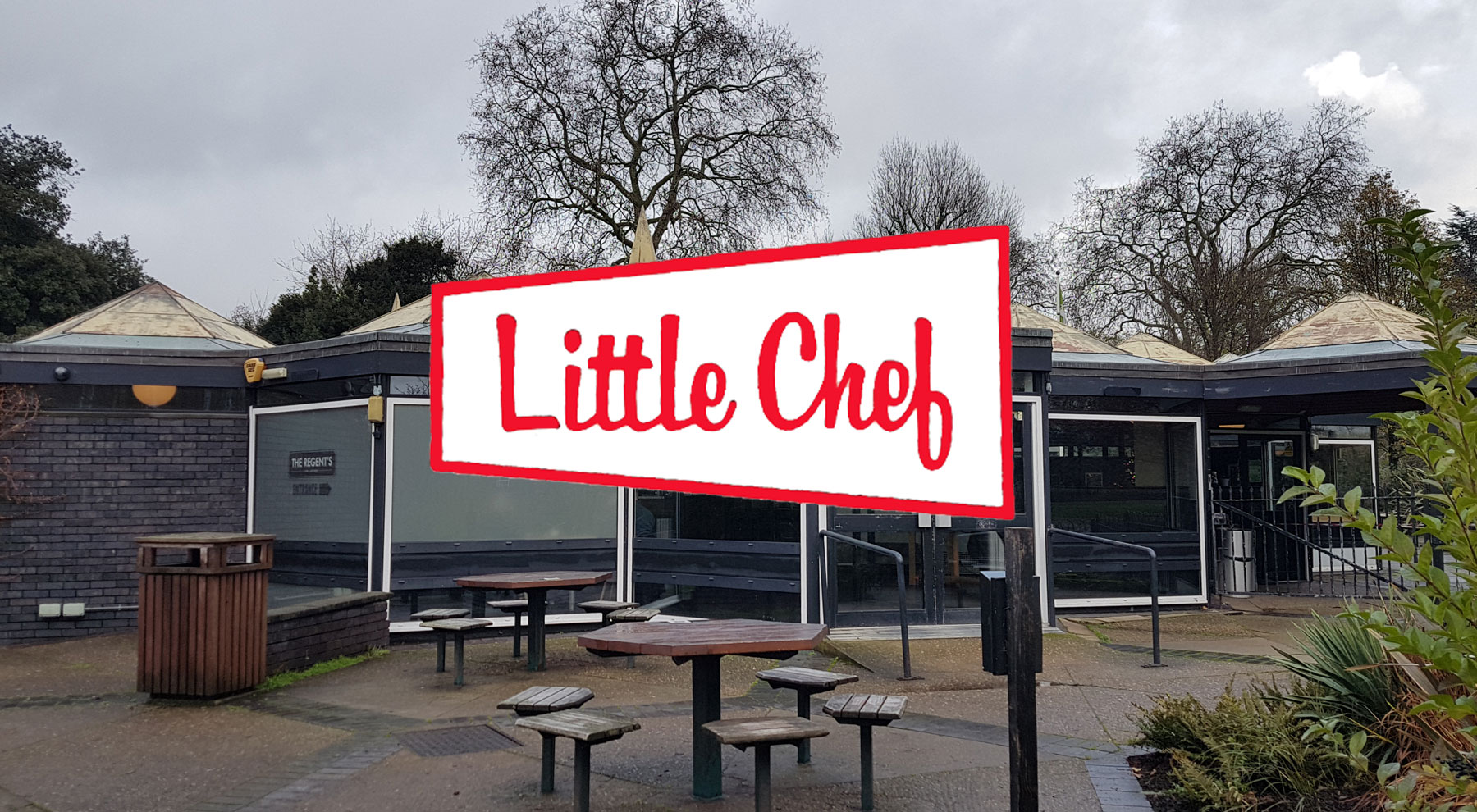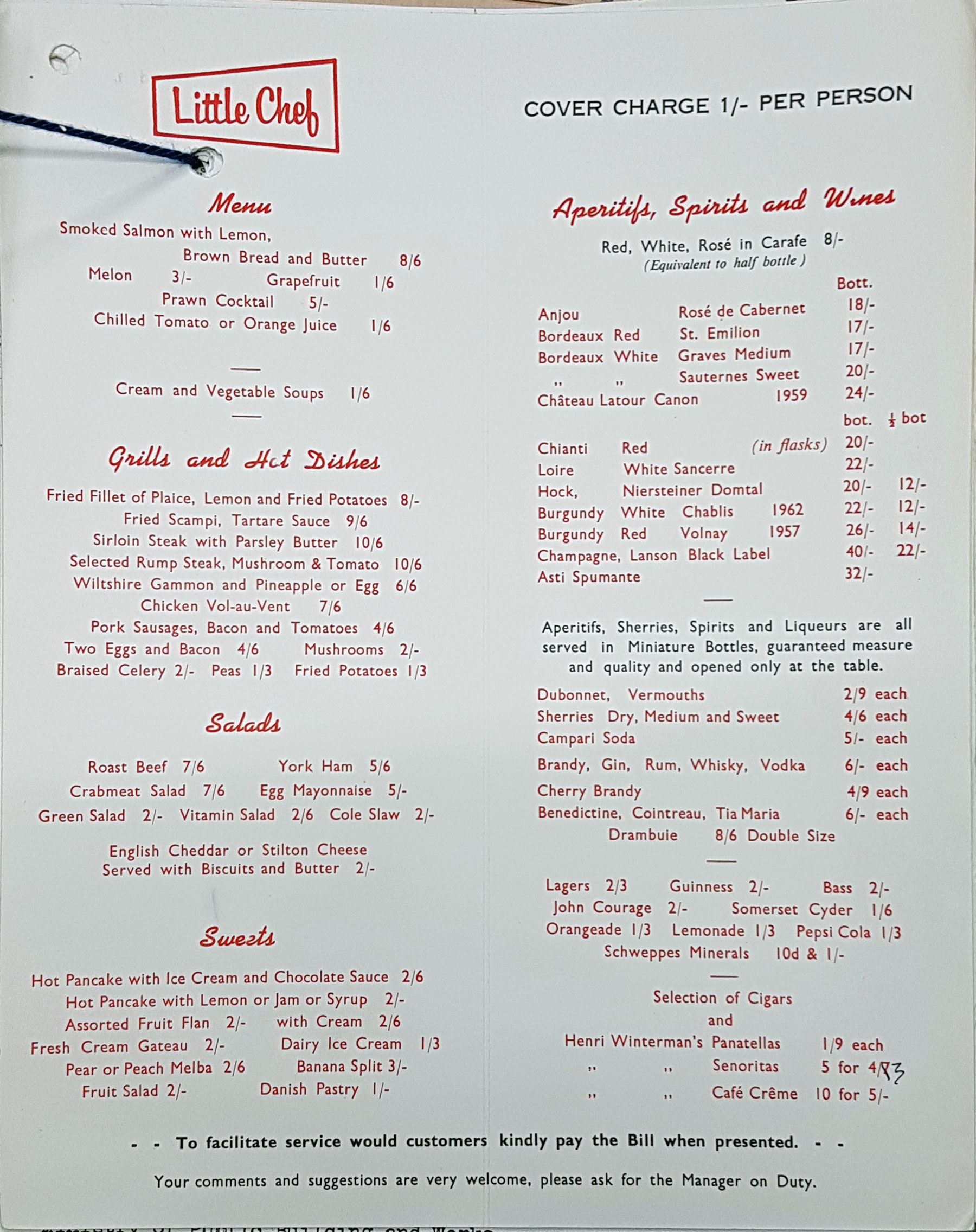Little Chef, a famous chain of basic roadside cafes once had a restaurant in the middle of a Royal Park, about as far from the usual roadside cafes you could expect.
This is the strange story of how a Little Chef ended up in the middle of Regent’s Park.

Little Chef was founded in 1958, by the caravan maker, Sam Alper and the catering firm, Peter Merchant. In 1962, Trust Houses bought Peter Merchant, and thus took over Little Chef, which was still a fairly small, but fast-growing operation.
It was to grow to become one of the UK’s largest roadside restaurant chains, famous for their “Olympic Breakfast” and “Jubilee Pancakes”. Peaking at 439 cafes, the chain struggled at the turn of the century and is now just a fond memory for people of a certain age.
But, back to 1962, the company was keen to expand, and the government was equally keen to do something about the poorly run cafes in London’s Royal Parks.
It’s a bit of a muddle, not helped by the fact that numerous sources report that Little Chef had branches in Hyde Park, and fewer mention Regents Park.
In fact, the contract to run restaurants in Hyde Park when to Fortes, who would in a curious twist, later go on to buy Trust Houses and end up owning Little Chef, but back in 1962 they were rivals.
Following a tender by the government it was decided that Hampton Court and Bushy Park were to be managed by John Gardner Caterers; Regents Park by Peter Merchants, and Hyde Park by Fortes.
Even though no contracts had been signed, by the middle of 1963 they were being set an ambitious target of opening their new restaurants for Easter 1964, less than a year since discussions had started.
The discussions were to take longer than anyone expected, thanks to the unique nature of the Royal Parks themselves, and it turned out to be surprisingly difficult for the government to lease land to commercial restaurants.
Thanks to an old law, the Crown Lands Act of 1702, they would struggle to offer the sort of commercial lease that the caterers would need to be able to cover the cost of building the new restaurants.
One of the ways around the problem was for the caterers to build the new restaurants, but then to immediately hand them to the government, in exchange for keeping all the profits until they recovered their costs.
The wording of the contracts had to be very carefully designed to allow construction to go ahead, while not at any point sounding like the caterers were getting a lease. Which sounds like a stupidly complicated way of doing things, but it was the only way around a problem caused by a 250 year old law.
Hyde Park, which was to be run by Fortes proved to be the most contentious in terms of the design of the new restaurants, and having to deal with so many external organisations to get approval. The designs had to be smiled upon by the Minister for Public Building and Works Geoffrey Rippon MP, the Royal Fine Art Commission, the Baliff of Parks, even the War Office were involved.
At one point, the Minister, clearly showing his social leanings, wondered if they could preserve some of the trees that might be lost at the site of one of the Hyde Park restaurants “as they had done at Glyndebourne”. The Minister was no old-fogey though, being the man who nearly demolished the grand old Foreign and Commonwealth Office in favour of something more modern.
On Thursday 31st October 1963, the plans were announced for strikingly bold looking and “gay modern restaurants” were to be provided in Hyde Park, offering “meals at reasonable prices”.
The Serpentine and The Dell were to be the names of the two venues.
The branch at the western end seemed to be a more basic affair, as there are job adverts in the Kensington Post in 1966 seeking staff for the “Serpentine Cafeteria, whereas adverts for the eastern end referred to the Serpentine Restaurant, later renamed the Dell Restaurant.
At the time Tatler described it as “Not sensational, but pretty enough to eat in”.
Both were designed by Patrick Gwynne, but in very different styles.
The eastern building was the more dramatic of the two and described as “a cluster of giant umbrellas”
Sadly it was demolished in 1989, to make way for a car park. The other restaurant was a simple petal design with the heavy concrete roof seemingly impossibly perched on top of the glass walls, and still remains as a working restaurant to this day.
The first of the two Hyde Park venues opened on 13th May 1964, with the Minister of Public Buildings and Works, Geoffrey Ripon MP doing the ribbon-cutting honours.
It’s notable though, that while there are various reports of Little Chefs opening in Hyde Park, neither of the restaurants were Little Chefs, even though Little Chef themselves say they ran them. They didn’t, not in Hyde Park at least.
Meanwhile, over at Regents Park, Peter Merchants were busy trying to get their restaurant up and running. An initial idea to build an extension to the existing cafe, known as the West Lodge in Queen Mary’s Rose Garden was swiftly dropped in favour of a new modern building.
When the plans were presented, the government’s Chief Architect noted dryly that there is an “epidemic of hexagonitis for we now have three firms who are of the mind that the solution for a park restaurant lies in a multiplicity of hexagons.”
That said, they went with a hexagon scheme anyway, but it took longer to get construction started than expected as the old cafe site included the retired park keeper’s home, and he needed to be offered a replacement home somewhere else.
Construction of the new restaurant was estimated to cost around £54,000.
They also faced the same legal challenges in Regents Park as they had in Hyde Park – in the difficulties of signing a commercial lease due to the nature of the Royal Parks. In fact, sorting out the problems opened a bit of a can of worms as to the legal status of the nearby Open Air Theatre, and nearly imperilled its existence at the time.
In the end, the mess was sorted out when the Queen was asked to issue an Order in Council, granting permission for the restaurant to be built. It could be said that The Queen personally authorised the opening of a Little Chef in Regents Park.
A public announcement of the plans for a “gay new restaurant” seating 330 people was finally made on 16th December 1963.
Demolition of the old building started almost immediately with the aim of opening some of it in time for Whitsun (May 1964), with the finished restaurant fully open by the end of June.
Things go a bit quiet, works progress, then suddenly Little Chef appears.
The announcement that it was to be a Little Chef seems sudden. No documents or minutes seem to exist as to the sudden change. One day it’s a gay restaurant, and the next its a Little Chef.
It’s doubly odd as Little Chef at the time described itself as “Catereers to the Motorist”, and there aren’t many motorists in the middle of Regent’s Park.
The Regent’s Park branch of Little Chef was opened by the Parliamentary Secretary to the Ministry of Works, Richard Sharples on Thursday 2nd July 1964 — at a time, when it was said you “couldn’t buy a sandwich in the Royal Parks that one would risk feeding to the ducks. Now, you can actually dine!”
Although very popular when it opened, it wasn’t to remain a Little Chef for long. In fact, the demise of the restaurant as a Little Chef was almost entirely down to its own popularity.
Just a few months after it opened, Peter Merchants was already in talks with the government to expand the restaurant to cope with demand. It seems that the decision was taken in favour, as the Little Chef closed on 31st October 1965 for the winter season and for the extension building works to start.
Although the Little Chef had been run by Peter Merchants, in October 1964, John Gardner Caterers became a subsidiary of Trust Houses when it acquired the parent company of Peter Merchant and Little Chef, and they took on the management of the better parts of the company.
This is what seems to have killed off the Little Chef in Regent’s Park.
Peter Merchants having founded Little Chef clearly liked the chain, while John Gardner Caterers seemed less interested.
On 25th November 1965, B.J. Gardener wrote to the Ministry noting that “there are quite a number of small roadside restaurants in operation under the name of Little Chef and they have very little in common with the Regent’s Park Restaurant,”
He proposed that when the enlarged restaurant reopens, they rename it the Rose Garden Restaurant.
Permission was granted, with the Ministry official noting that he always thought naming it Little Chef was “an unfortunate choice and more reminiscent of a pull up for lorry drivers than the very pleasant building in Regent’s Park.”
Considering how the Ministry micromanaged the whole operation, right down the cost of ice-creams and placement of signs, the chances of the name Little Chef being approved against their wishes is pretty much non-existent, even if they later wanted to claim it was an unfortunate choice.
The restaurant reopened in April 1966 as the Rose Garden Restaraunt.
But, for about a year, there was a Little Chef in the middle of a Royal Park.
There’s a slight final twist in the tale though. When the final letter was sent to the Minister confirming the change of name, the Parliamentary Secretary, K Newis scribbled “ugh!” on the note.
Was he against the change?
We will never know.
Sources:
Birmingham Daily Post – Friday 1 November 1963
Illustrated London News – Saturday 23 May 1964
Daily Herald – Friday 3 July 1964
Kensington Post – Friday 18 March 1966
The Tatler – Saturday 11 June 1966
National Archives – WORK 16/2454
National Archives – WORK 16/2258













Fascinating…. Amazed to see from the menu that chicken vol au vent is priced at 7/6 when plaice and chips is “only” 8/-. Perhaps vol au vents were bigger in those days. Not that I can remember ever coming across a vol au vent in the 60s, certainly not in a “regular” Little Chef.
So does that mean Little Chef is returning?! I used to go to Little Chef many times. Even on longer journeys. And their food was so delicious.
I don’t see how an article about a Little Chef in the 1960s would suggest it’s reopening in the 2020s.
Oh the joy of a Little Chef greasy english breakfast with white bread to soak it up, the rain lashing on the almost portacabin windows whilst on the way back up Lunnon from a hungover desire to see Stonehenge at dawn.
There’s something to ask Santa for next time.
Merry Christmas and as ever bravo Mæstro! Thanks.
Is it really true that Little Chef is coming back. I thought that Little Chef was gone forever.
I refer you to my previous reply.
Interesting story. Thanks. As far as I recall, the Little Chefs were utterly depressing places, consistent with 1960s Britain at its most insular and second-rate. Motorway service areas of the era were similarly dire. Still, maybe distance lends enchantment, as the proverb puts it.